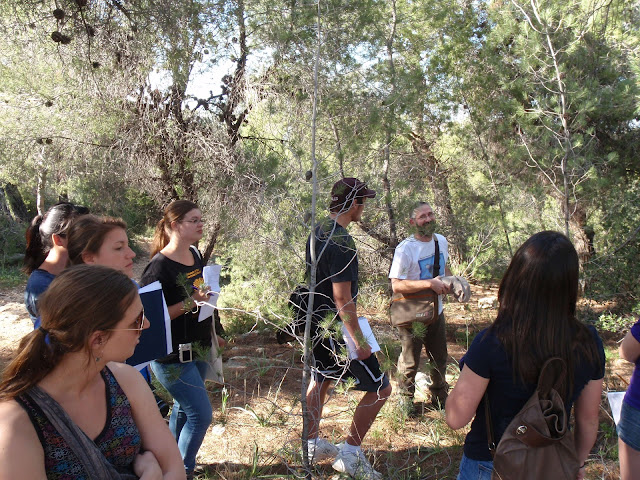April 25th 2012. Walk with students up a hillside on Mount Hymettos, near the Monastery of Agios Ioannis of Kareas. It took us just a 15 minute taxi ride to get hear from the center of Athens. There is nature here. Simple, diverse, and an outdoor classroom for the students of Collage Year in Athens. All we needed were two hours - a simple loop walk. Some snapshots from our walk follow...
 |
| Start of the walk just beyond the Monastery - bright sun at about 17:00. |
 |
| A Euphorbia acanthothamnos - Greek Spiny Spurge. A typical plant of the Greek phrygana scrublands. |
 |
| Aleppo Pine forest. Woods existed on the mountain in the past - but the recent forests were planted after WWII. |
 |
| We studied the differences inside the forest. If felt different. Under rocks we say huge centipedes, spiders, some-one found a tortoise shell. We could have searched more. |
 |
| Beyond the forest was a huge burn - a recent fire had swept through. But it was full of life and regeneration. |
 |
| An amazing view of the city from the near-silence of the hills. The city is like a sea of buildings - and inside that sea are small parks and hillocks - islets. |
 |
| Another spurge: Red Spurge Euphorbia characias. Exotic-looking but native. Actually very few non-indigenous plants grow in this species-rich hillside. |
 |
| Close look at the flowers - they vaguely resemble a Poinsettia's because they are both in the Euphorbia family. |
 |
| A delicacy: Wild Asparagus grows in the scrublands. We chose not to eat this specimen. Constraint is good. |
 |
| We climbed up above the city-scape. Higher up some plants were in full flower - the Asphodel. |
 |
| Asphodel is one of the most widespread plants in the Phrygana and within the pine woods. This is a plant in the Lily Family - typical lily flowers. |
 |
| My friend, the Forester and Artist Vassilis Hatzirvassanis joined us and helped guide us. Here he helped explain details of the fire history of these slopes. |
 |
| Successive fires leave a patchwork of woods, regenerating pine thickets, phrygana and evergreen scrub thickets. If the pine tree-lets are burned before their cones mature they will not regenerate and scrubland will take over. |
 |
| Vegetation dresses up the landscape - its alive and dynamic. People should accept fire - and its affects on the Mediterranean landscape: its not all that bad. And there is so much diversity because of fire! |
 |
| Helichrysum is a kind of 'Everlasting'growing on the dry rocky soils. Many of the really most spectacular plants I did not photograph. It was like a rock gardent - but totally wild... |
 |
| We saw a huge number of plnats in flower - some are special because they are scarce or are found only in a small part of Greece. This thistle - Centaurea raphanina is endemic to Greece. |
 |
| Hatzirvassanis explain how the flower of Jerusalem Sage is pollinated. Ingeniously set brush on the flower dusts the insect with pollen. |
 |
| A grasshopper. There were many insects out today about -mostly bees and wasps; only a very few butterflies. |
 |
| We sat on the forest floor on our descent. We contemplated what this place would have looked like 100 years ago. Beneath us was an old stone-built terrace, and land on this soil was cultivated - orchards, vinyeards right beside the monastery. |
 |
| Today its a forest. And most people may consider it static - it is ever-changing just like any cultural landscape in the Mediterranean. |
 |
| I think we had a nice day. Back at the parking lot of the Monastery at exactly 19:00. That's all it takes. |




















